

The Project Gutenberg eBook of Slave Narratives, A Folk History of Slavery in the United States From Interviews with Former Slaves. Slave Narratives: Chronological List of Autobiographies. The Anti-Slavery Alphabet - Mississippi Department of Archives and History. Abstract article Middle Passage J Chassot. Slaves Waiting for Sale: Abolitionist Art and the American Slave Trade, McInnis.
Scientific American Frontiers . Unearthing Secret America . Slave Housing at Monticello. Black Patriots and Loyalists: Fighting for Emancipation in the War for Independence, Gilbert. Enduring Truths: Sojourner's Shadows and Substance, Grigsby. Who Freed the Slaves?: The Fight over the Thirteenth Amendment, Richards. How Watermelons Became a Racist Trope.
It seems as if every few weeks there’s another watermelon controversy.
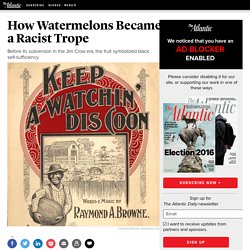
The Boston Herald got in trouble for publishing a cartoon of the White House fence-jumper, having made his way into Obama’s bathroom, recommending watermelon-flavored toothpaste to the president. A high-school football coach in Charleston, South Carolina, was briefly fired for a bizarre post-game celebration ritual in which his team smashed a watermelon while making ape-like noises. While hosting the National Book Awards, author Daniel Handler (a.k.a. Lemony Snicket) joked about how his friend Jacqueline Woodson, who had won the young people’s literature award for her memoir Brown Girl Dreaming, was allergic to watermelon. David Krugler, “1919, The Year of Racial Violence: How African Americans Fought Back” (Cambridge UP, 2014) "Prince Estabrook," from African American National Biography. Citation :Daut, Marlene.
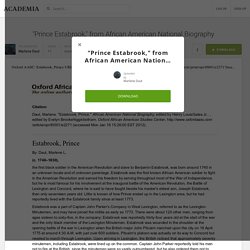
"Estabrook, Prince. " "Powhatan Beaty," from African American National Biography. Fine, dramatic situationsÓ (Hill, 83).
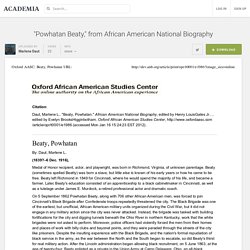
Finally, in 1888 Beaty became the drama director of the Literary andDramatic Club of Cincinnati, a club that he had helped form.Little is known about Beaty's life after 1890, but a historical marker that is a part of the Underground RailroadHeritage program states that he died on 6 December 1916, Òleaving two sons, attorney and staterepresentative A. Lee Beaty and John W. BeatyÓ (Grace, 50). As a testament to Beaty's important place in U.S.history, more specifically his involvement in the Civil War, House Bill 897, dated 10 February 2000, designatesthe Interstate Route 895 (Pocahontas Parkway) bridge over Virginia Route 5 the ÒPowhatan Beatty MemorialBridge.Ó Powhatan Beaty, along with many other prominent African American figures, is buried in the UnionBaptist Cemetery in Cincinnati, the oldest African American religious burial ground still in use. Further Reading. 100 Amazing Facts About the Negro. List of African-American inventors and scientists.
Famous Black Inventors. The Faces of Science: African Americans in the Sciences. The Faces of Science: African Americans in the Sciences The Past: "What Has Happened Before? " Profiled here are African American men and women who have contributed to the advancement of science and engineering. The accomplishments of the past and present can serve as pathfinders to present and future engineers and scientists. The Secret Histories Project. The Big Idea: 7 Groundbreaking Black Female Inventors « MadameNoire MadameNoire. America is known for her spirit of inventiveness, and black women have been major contributors in our country’s history of ingenuity.
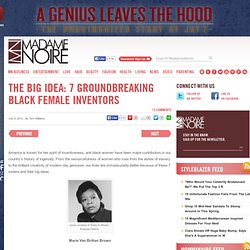
African Influences in Modern Art. During the early 1900s, the aesthetics of traditional African sculpture became a powerful influence among European artists who formed an avant-garde in the development of modern art. In France, Henri Matisse, Pablo Picasso, and their School of Paris friends blended the highly stylized treatment of the human figure in African sculptures with painting styles derived from the post-Impressionist works of Cézanne and Gauguin.
The resulting pictorial flatness, vivid color palette, and fragmented Cubist shapes helped to define early modernism. Influence of African Art on Cubism - African-American History Through the Arts. The Black Press: Soldiers Without Swords. ‘We Have to Do Better': A Reading List on the Charleston Church Massacre. Yesterday, Marc Lamont Hill tweeted, “I’m going to need all White people to denounce this ugly act of racist domestic terrorism.”
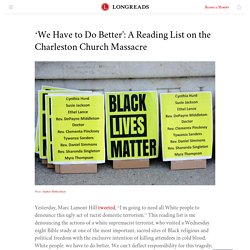
This reading list is me denouncing the actions of a white supremacist terrorist, who visited a Wednesday night Bible study at one of the most important, sacred sites of Black religious and political freedom with the exclusive intention of killing attendees in cold blood. White people: we have to do better. We can’t deflect responsibility for this tragedy; we can’t blame this on mental illness (many of my friends and I deal with mental illness every day; none of us have murdered anyone).
We have to demand accountability from one another and stand up for people of color—in the streets, in our Facebook feeds, in our offices and homes. 1. White Americans will not have to look in the mirror and ask, “what does it feel like to be a problem.” 2. Pacific Standard. Carolyn Finney, "Black Faces, White Spaces" (UNC Press, 2014) Episode 628: This Ad's For You : Planet Money.
Tom Burrell, ad man.

Courtesy of Tom Burrell hide caption. The Kitchen Sisters. The Pilgrimage of Malcolm X by I.F. Stone. The Autobiography of Malcolm X with the assistance of Alex Haley Grove, 455 pp., $7.50 Malcolm X Speaks edited by George Breitman.
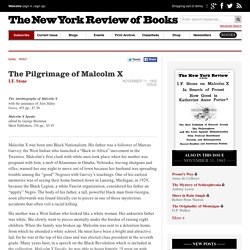
Father Recreates Famous Photos with His Daughter. Brooklyn photographer Marc Bushelle and his wife, Janine, didn’t anticipate the overwhelming attention they would receive when they first had the idea to feature their 5-year-old daughter Lily portraying photos of iconic African-American women.
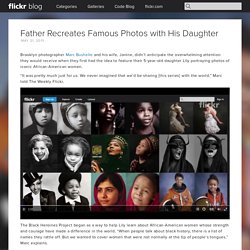
“It was pretty much just for us. We never imagined that we’d be sharing [this series] with the world,” Marc told The Weekly Flickr. The Black Heroines Project began as a way to help Lily learn about African-American women whose strength and courage have made a difference in the world. “When people talk about black history, there is a list of names they rattle off.
Forgotten African American Stories, Told in Comic Books. Home to about 50 mixed-race descendants of a freed slave, Malaga Island off Maine’s coast seemed an oasis of racial harmony in 1912.
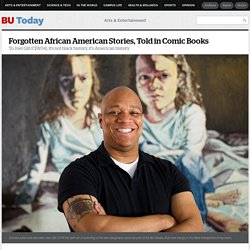
But then the state, lobbied by reformers who saw residents living in poverty—and perhaps tempted by a land grab too good to pass up—evicted the islanders. The majority who complied were the lucky ones. Those who held out were netted in the nascent eugenics fervor: declared feebleminded, they were confined and in some cases castrated. Despite an official apology from Maine’s governor in 2010 and a radio documentary about the case, Malaga’s story might have remained little known but for Joel Christian Gill (CFA’04).
The Life and Death of Mr. Basketball. For years, Italy has been an essential stopover for American basketball players on the rise.

Hall of Fame coach Lou Carnesecca once said Italy had the third-best league on earth, after the NBA and NCAA. Bill Bradley played there; former New York Knicks coach Mike D’Antoni was a player and a coach in Italy for almost twenty years. Kobe Bryant actually grew up there, when his father left the NBA to play for a team in Rieti, Italy. He still speaks good Italian, and the interviews are on YouTube to prove it. Classic Ladies of Color. Looking Harlem in the Eye by Darryl Pinckney.
Carl Van Vechten (1880-1964), enthusiast of Modernism and ally of the Harlem Renaissance, had a swell time while the Roaring Twenties lasted. Maybe he had too good a time—man about town, his big-toothed smile not to be missed at important theater openings and literary events, then on to suppers and cabarets. “Up at 8 with quite a hangover,” Van Vechten typically notes in his small daybook. He ceased his binge drinking as the Jazz Age turned into the Great Depression and he also stopped writing fiction.
His dear friend Gertrude Stein had been right not to take his novels of decadence too seriously. Yet Van Vechten would have the Second Act that American life is not supposed to grant. Van Vechten came from a sort of rich family, and perhaps that was the source of his social confidence. Fifty Years Later - Home. 100 LGBTQ Black Women You Should Know: The Epic Black History Month Megapost. Black, queer, feminist, erased from history: Meet the most important legal scholar you’ve likely never heard of. AAME : image. Obit of the Day: Creator of “Luther” In 1968,...
Black Women Matter by Underground Sketchbook. San Diego Air & Space Museum - Balboa Park, San Diego. 1900s Emory Conrad Malick becomes first African American pilot, trained at the Curtiss Aviation School at North Island in 1912.Eugene Jacques Bullard becomes first black fighter pilot in France (1917). 1920s. A Study of Frances E. W. Harper's Feminist(ic) Writings.
"Wrongs to Be Righted"[1] A Study of Frances E. W. Harper's Feminist(ic) Writings. Black Nashville Genealogy & History. The Forgotten Radical History of the March on Washington. Salviprince.tumblr. A Racial History of Drowning. A male white Bengal tiger cub ducks as a female Bengal jumps over him. (NancyChan/AP) How African Americans beat one of the most racist institutions: The swimming pool. The Inkwell, Santa Monica, California (1905-1964) Hazel Maybier Brown-Temple (far right) and. Photos: When Santa Monica Beach Was Segregated: LAist. Watch Now: Black Surfer Feature Doc 'White Wash' Narrated By Ben Harper, Black Thought. The Spy Photo That Fooled NPR, the U.S. Army Intelligence Center, and Me - Lois Leveen. King Institute Encyclopedia. 8 Successful and Aspiring Black Communities Destroyed by White Neighbors. Black Archives of Mid-America Kansas City. Black Pulp Fictions: Yesterday and Today. Dated January 25, 1870, these are the credentials.
New book lionizes America’s first black public high school, source of many African-American greats. 1956 Black History Viewed Through Magazines : un album sur Flickr. Search Results: "" - Prints & Photographs Online Catalog. Facial Hair Friday: Portrait of the Artist with a Mustache. Stop Whitewashing. The African American woman pictured above, Zelda... Stop Whitewashing. Gradient Lair. Audiophile Life. Stop Whitewashing. National Postal Museum. An Ancestry of African-Native Americans- page 1. Young Black and Vegan - classicladiesofcolor: Before she became known as... Gallery - The Wayland Rudd Collection. Cold Town, bellecs: winningthebattleloosingthewar: On the... Great Performances . Aida's Brothers and Sisters: Black Voices in Opera. The Spirit of New Orleans — For decades, the Baby Dolls were among the more... WPA Federal Theater Project in New York:Negro Theatre Unit:"Macbeth", ca. 1935.
Performer Spotlight: The Women of '20 Feet from Stardom' African American Women Writers of the 19th Century. African-American Women in the Sciences - Tracer Bullet. Noted Negro Women: Their Triumphs and Activities : Monroe Alphus Majors , Majors, Maggie I Stevens, Julia Ringwood Coston, Theodora Holly , Ruth May Fox, L Johnson, Sarah G Jones , Sarah E C Dudley Pettey, Gertrude E H Bustill Mossell , Imogene Howard , O. The Brave Black Women Who Were Civil War Spies. Sandra K. Johnson, Ph.D. - Home. This 80-Year-Old Grandma Walked Hundreds of Miles to Retrace the Underground Railroad by Katrina Rabeler.